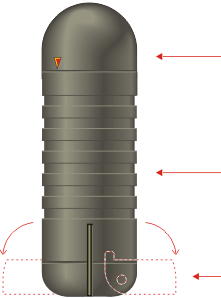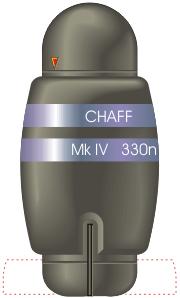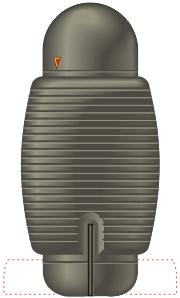
These grenades employ force field technology to create an explosive effect. The grenade consists of a small field generator and a power pack adequate to form one uncontrolled spherical force field which expands rapidly to a preset diameter before becoming unstable and dispersing. As the field expands at a rate of approximately 0.25m per nanosecond, the resulting shockwave can have some quite spectacular effects. The longer the field is allowed to expand, the greater the effect — and the greater the expense. Their advantage over old-fashioned chemical explosives lies in the fact that the fields can be easily configured by the user to create a shockwave of any power up to the factory-specified maximum for the model.
 |
Mode select and primer: Pull out, twist to set timer, push back in to start timer or set for impact detonation |
| Locking ribs for special-purpose casings | |
| Stabilising fins (spring operated) | |
| Basic Unit: Concussion |


The basic model shown here is the most common variety available, and can be thrown by hand, or projected by means of a clip-on launcher from a standard blast rifle or carbine which incorporates an automated timing mechanism so that the grenades may be configured while in the breech. Specialised launchers with sights designed for indirect fire are also available. The basic grenade can be fitted with one of a number of special-purpose casings; shown here are the chaff and fragmentation cases. Also available are sticky gel cases, used to prevent post-impact bouncing for timed bombs, and slippery low-friction cases to decrease the likelihood of a bomb being picked up and thrown back.
The basic unit is contained in a polymer casing designed to disintegrate into dust under pressure as the field is generated, and thus create minimal shrapnel, although of course incidental debris may be flung about by the explosion.
Costs for the basic units are as follows:
Smoke and incendiary grenades are also available for use in the same launchers as force-field grenades, but they employ standard chemical reaction technology for their effects.
An interesting variant on the standard grenades are "Push-field" units, which generate their fields at a much slower rate (usually approx. 10 m/s). They are designed for use in situations where a violent explosive effect is inadvisable, and can be calibrated in the field to produce a field any size up to their factory-set maximum diameter. the field can be generated in a spherical or cylindrical format, but this is factory set and cannot be altered. The effect is similar to being bowled by a car at approx. 40 km/h, and while dangerous, is seldom immediately lethal as long as the victim is not caught between the expanding field and an immovable object such as a concrete wall � if that happens, it's tomato-paste city.
Cost is dependent on the maximum field diameter the grenade is capable of generating: